By Eoghan Daltun
Published online October 14th 2024
The opinions expressed in this blog are those of the author and do not necessarily represent those of the Irish Wildlife Trust.
Guest Writer in Irish Wildlife Magazine Autumn 2024 Issue. Get your copy of the latest magazine by joining IWT today.

In 2009, I sold my small house in Kilmainham, Dublin, and used the proceeds to buy a 73-acre farm near Eyeries on the north side of the Beara Peninsula, West Cork. It was the start of a fantastic journey, and a deep dive into wild nature that has never stopped since.
Many things attracted me to this particular piece of land: the stunning views, looking out over the open Atlantic, Deenish and Scarrif islands, the Skelligs, the Iveragh Peninsula, and the MacGillycuddy Reeks mountains, including Ireland’s highest, Carrauntoohil. The terrain is hugely complex, with towering escarpments, deep gorges, massive erratic boulders, ‘knife-edge slabs’, and many other markers of deep, geological time. All this is traversed by a weave of streams, which become rushing, foaming torrents after heavy rain.
But the most outstanding feature of all is the extensive covering of wild temperate rainforest. In the years after moving to the area, I was able to piece together how this ecological wonderland came to be. Essentially, the family that lived here in the past, the Crowleys, had mostly emigrated to the United States in the early 20th century, leaving the land largely unfarmed.
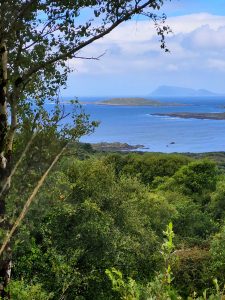
Eoghan’s woodland at Bofickil overlooking the Atlantic, photo from The Magic of an Irish Rainforest.
The general absence of grazing livestock allowed surviving pockets of wild native trees to seed themselves back out, recolonising patches of ground in between: a mixture of sessile oak, downy birch, holly, grey and eared willow, hawthorn, rowan, hazel, blackthorn, alder, ash, and wild apple. Equally importantly, the rest of the ecosystem was able to follow: the flowers, ferns, mosses, insects, lichens, microbes, mycorrhizal fungi, and so on.
The first time I saw the place, I was in complete awe of its beauty and wonder, almost to the point of feeling overwhelmed. But I was also aware that something was deeply wrong. The forest floor was stripped entirely bare, as if an army equipped with petrol-driven strimmers was constantly moving through the forest, obliterating all vegetation below head height. In addition, Rhododendron ponticum and many other alien invasive plants were running rampant.
The root cause of the problems wasn’t long in revealing itself: a mob of feral goats, whose central hangout was the forest on the farm. The International Union for the Conservation of Nature (IUCN) has a list of the world’s 100 worst alien invasive species, and it’s for very good reason that goats feature on it. They devour almost all native vegetation, including tree seedlings and other important flora, but leave most non-natives like rhododendrons alone.
The result is that ecosystems are unable to regenerate, so over time they simply die away with no younger trees to replace aging elders. The goats had also been peeling the bark from many of the tree trunks, leaving the forest littered with dead trees. Another invasive herbivore, sika deer, brought to Ireland from far east Asia in the 1860s, was also making a significant contribution to this ongoing ecological meltdown. And the severe overgrazing caused by these two species was creating the ideal conditions for a host of invasive plants like Rhododendron ponticum to spread rapidly.
To rectify the situation, I applied for a grant under the Native Woodland Scheme (Conservation element) to fence out the goats and sika from around 21.5 acres where most of the forest was. Meanwhile, in my spare time I set to work eliminating the rhododendron and about 8 other invasive plant species. After 18 months, the grant was approved and contractors spent a couple of weeks putting up a 2m-high fence, an extremely arduous job given the rough terrain.
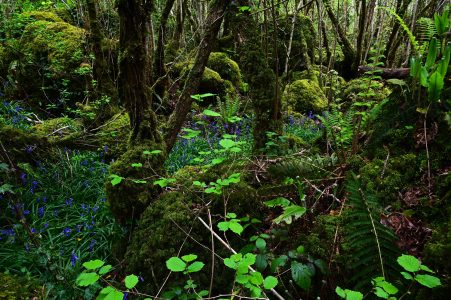
Native woodland diversity with bluebells and Hart’s-tongue ferns, photo from The Magic of an Irish Rainforest.
These efforts paid off spectacularly. Over the following months and years, I was witness to the most wonderful explosion of life in all its diversity and abundance, as the ecosystem responded to the lifting of artificial grazing pressure.
Native tree seedlings began to pop up everywhere, and were able to carry on growing into what has since become new rainforest. The existing forest erupted with wildflowers and other flora that I had presumed wasn’t present at all: wood anemone, bluebells, herb Robert, primrose, sanicle, yellow pimpernel, dog violet, bugle, and scores of others.
All this floral flourishing created a veritable boom in insect and bird life, and several previously absent relatively rare native mammals have since moved in or started to come by: lesser horseshoe bats, pine martens, and otters in the streams. It has been pure joy to play a part in this renaissance, a process which, over 12 years later still goes on, and which has changed my life profoundly alongside the ecosystem itself. However, it has also brought me deep pain. Why, you may ask?
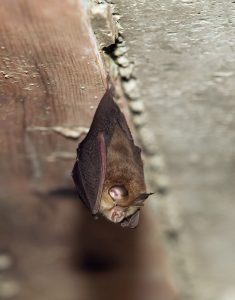
Lesser horseshoe bats are part of Atlantic rainforests biodiversity, photo by Mike Brown.
Experiencing firsthand how rich nature can be in Ireland, means that now, virtually everywhere else I look, I see only empty, biological deserts. From one end of the island to the other, we have turned Ireland into one big farm, predominantly filled with cattle, sheep, or tree plantations. Monocultures of the associated perennial ryegrass, purple moorgrass, or Sitka spruce now dominate where rich, diverse, natural ecosystems once thrived.
Even those few, tiny places whose primary purpose should be to offer sanctuary to wild nature – our national parks – are wrecked. Visit Killarney National Park near me, for example, our most extensive remaining fragment of rainforest (or native forest of any sort), and you’ll find a dying ecosystem, being killed by exactly the same factors that were afflicting my place: sika, goats, and rhododendron. Ecologists have been calling out the situation in the park for over half a century now, yet little changes, even under the current coalition government that includes the Green Party. It’s simply outrageous, not to mention maddeningly frustrating and depressing.
Visit other national parks and pieces of wild habitat across the country, and you’ll generally find the very same scenario. In 2018, the Natural History Museum of London compiled what was called a ‘Global Biodiversity Intactness Index’, which looked at all 240 nations and states on the planet, ranking them according to how nature is faring. Ireland came in thirteenth from the bottom (Northern Ireland is worse, at twelfth). All the other data we have is screaming the very same message: Irish nature is in a desperate state, and getting worse.
But now, having thoroughly depressed the reader, I want to tell you I sense that things are starting to shift radically. In September 2022 my book telling the story of moving to Beara and restoring the forest was published. Sales of ‘An Irish Atlantic Rainforest: A Personal Journey into the Magic of Rewilding’ exceeded my wildest expectations, becoming a national bestseller and selling copies all over the world. It also won an An Post book award, and has been shortlisted for the Royal Irish Academy’s Michel Déon Prize (the winner of which will be announced in late October). A documentary film is being shot in the forest, for showing to Irish and international audiences.
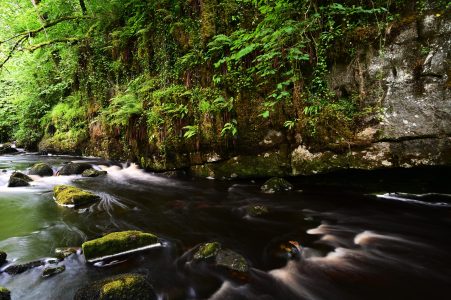
The sum of our planet’s natural ecosystem is known as the biosphere. River and woodland ecosystem at Cladagh Glen Fermanagh, photo from The Magic of an Irish Rainforest.
I’m convinced none of this would have been possible without a real hunger on the part of Irish people for a new relationship with the natural world. There is an increasing awareness that the bare hills of Wicklow, Kerry, Down, and Mayo are not a natural state. That native forest now only accounts for only around 1% of overall land area, down from an estimated pre-farming original of 80%. That most of those surviving bits are in the same dying state as my place was when I arrived. That the invasive sika deer, which are making such a major contribution to the death of our last forests, are still protected by law. That our rivers have been turned from pristine arteries bursting with life into mere open sewers for carrying away excess water and pollution, mostly from farms. And so on, ad infinitum.
I feel a deep shift in consciousness is taking place, with ever fewer people prepared to simply stand by while what’s left of Irish nature continues to be flushed down the tube as though it were worthless. There is a palpable awakening in the form of curiosity about our natural heritage, and huge anger at how it has, and is being, annihilated, mostly to line the pockets of an already rich few. Is this change happening fast enough? I don’t know. All I can say is that this is the most important fight in human history, perhaps in the history of Earth itself: to preserve the communities of life – ecosystems – that have taken hundreds of millions of years (billions, in a sense) to evolve.
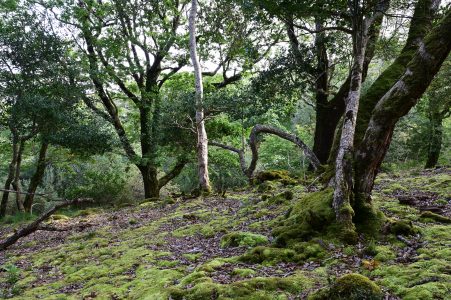
Overgrazed native woodland without regeneration, Killarney National Park, photo from The Magic of an Irish Rainforest.
All the scientific knowledge we have now tells us the same thing: our planet is only habitable because the sum of its natural ecosystems, known as the biosphere, make it so. By frenziedly killing off nature, we have been killing off a future for our own children and theirs, to say nothing of the millions of other species with every bit as much right as us to live out their lives without being driven to extinction, to continue their evolutionary paths.
Yet I am hopeful. Despite all the vested interests that are fighting tooth and nail to be permitted to continue to get rich by plundering nature. Despite all the remaining public ignorance and inbuilt aversion to change, I am hopeful. I believe the majority of people are waking up to what’s at stake, to the fact that we live in a miracle world of breathtaking beauty and wonder, and that it’s being annihilated, fast. There’s a rapidly increasing understanding of the need to start valuing and protecting nature, and allowing it to return through mass rewilding. My prediction is that in five or ten years, this new awareness will be starting to assume physical form, with a wilder Ireland taking shape.
But perhaps the thing that gives me the greatest hope is seeing, over the last 15 years, the sheer power of nature to heal itself of the damage we have done to it, with only a little human help. I experience this every day in my patch of wild Atlantic rainforest.
And as I have also found, in healing nature, we heal ourselves.
About the Author:
Eoghan Daltun is a sculpture conservator, a farmer, an author and, above all, a rewilder. Eoghan is a Trustee of the Irish Wildlife Trust and a leading advocate for rewilding in Ireland
Eoghan’s second book, ‘The Magic of an Irish Rainforest: A Visual Journey’ (Hachette), a photographic exploration and celebration of rainforests across Ireland, from west Cork to north Antrim, was published this September.
